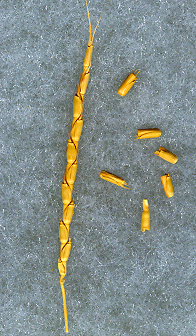Aegilops tauschii
Aegilops tauschii, also known as Tausch's goatgrass or rough-spike hard grass, is a species of grass in the Poaceae family. It is native to Western Asia and Eastern Europe, and it is an important wild relative of wheat.
Taxonomy[edit | edit source]
Aegilops tauschii belongs to the genus Aegilops, which is closely related to the genus Triticum, the genus that includes common wheat (Triticum aestivum). The species was first described by Carl Friedrich von Ledebour in 1830.
Description[edit | edit source]
Aegilops tauschii is an annual plant that typically grows to a height of 30-70 cm. The leaves are linear and can be up to 20 cm long. The inflorescence is a spike, which is composed of several spikelets. Each spikelet contains 2-5 florets. The glumes are rough and the lemmas are awned.
Distribution and Habitat[edit | edit source]
Aegilops tauschii is found in a variety of habitats, including grasslands, scrublands, and cultivated fields. It is native to regions spanning from Turkey and the Caucasus to Central Asia and Pakistan. The species has also been introduced to other parts of the world, including North America.
Genetic Importance[edit | edit source]
Aegilops tauschii is of significant genetic importance due to its role in the evolution of bread wheat (Triticum aestivum). The species contributed the D genome to the hexaploid bread wheat, which is a combination of the genomes from three different species: Triticum urartu (A genome), an unknown Aegilops species (B genome), and Aegilops tauschii (D genome). This genetic contribution has provided bread wheat with various beneficial traits, including disease resistance and stress tolerance.
Uses[edit | edit source]
While Aegilops tauschii itself is not cultivated for food, its genetic material is used in plant breeding programs to improve the resilience and yield of cultivated wheat varieties. Researchers utilize the genetic diversity of Aegilops tauschii to introduce new traits into wheat, such as improved drought tolerance and pest resistance.
Conservation[edit | edit source]
The conservation of Aegilops tauschii is important for maintaining the genetic diversity necessary for future wheat breeding efforts. Efforts are being made to preserve its natural habitats and to collect and store its seeds in gene banks.
See also[edit | edit source]
References[edit | edit source]
External links[edit | edit source]
Search WikiMD
Ad.Tired of being Overweight? Try W8MD's physician weight loss program.
Semaglutide (Ozempic / Wegovy and Tirzepatide (Mounjaro / Zepbound) available.
Advertise on WikiMD
|
WikiMD's Wellness Encyclopedia |
| Let Food Be Thy Medicine Medicine Thy Food - Hippocrates |
Translate this page: - East Asian
中文,
日本,
한국어,
South Asian
हिन्दी,
தமிழ்,
తెలుగు,
Urdu,
ಕನ್ನಡ,
Southeast Asian
Indonesian,
Vietnamese,
Thai,
မြန်မာဘာသာ,
বাংলা
European
español,
Deutsch,
français,
Greek,
português do Brasil,
polski,
română,
русский,
Nederlands,
norsk,
svenska,
suomi,
Italian
Middle Eastern & African
عربى,
Turkish,
Persian,
Hebrew,
Afrikaans,
isiZulu,
Kiswahili,
Other
Bulgarian,
Hungarian,
Czech,
Swedish,
മലയാളം,
मराठी,
ਪੰਜਾਬੀ,
ગુજરાતી,
Portuguese,
Ukrainian
Medical Disclaimer: WikiMD is not a substitute for professional medical advice. The information on WikiMD is provided as an information resource only, may be incorrect, outdated or misleading, and is not to be used or relied on for any diagnostic or treatment purposes. Please consult your health care provider before making any healthcare decisions or for guidance about a specific medical condition. WikiMD expressly disclaims responsibility, and shall have no liability, for any damages, loss, injury, or liability whatsoever suffered as a result of your reliance on the information contained in this site. By visiting this site you agree to the foregoing terms and conditions, which may from time to time be changed or supplemented by WikiMD. If you do not agree to the foregoing terms and conditions, you should not enter or use this site. See full disclaimer.
Credits:Most images are courtesy of Wikimedia commons, and templates Wikipedia, licensed under CC BY SA or similar.
Contributors: Prab R. Tumpati, MD

